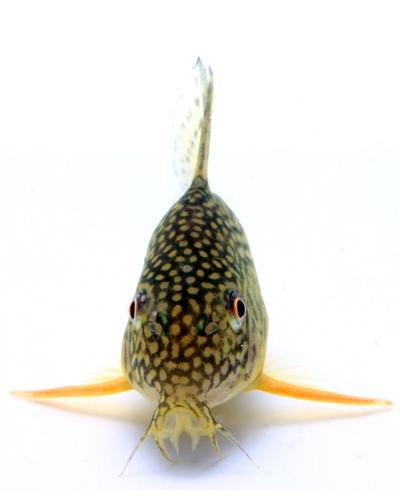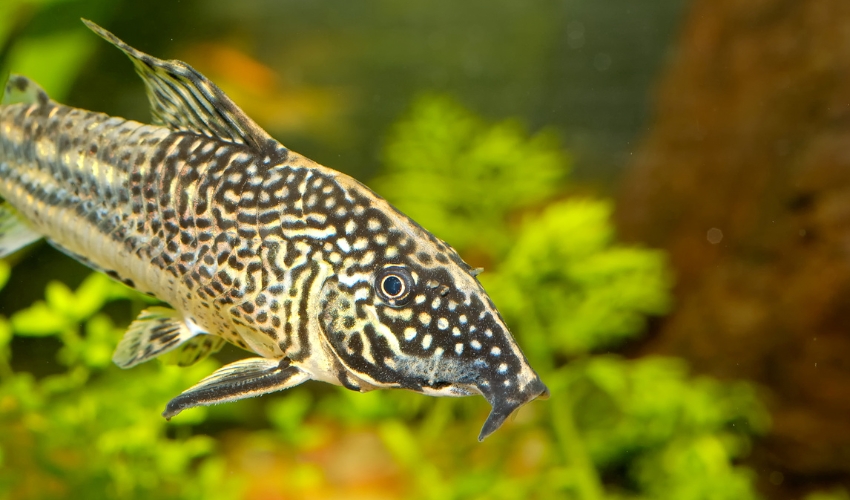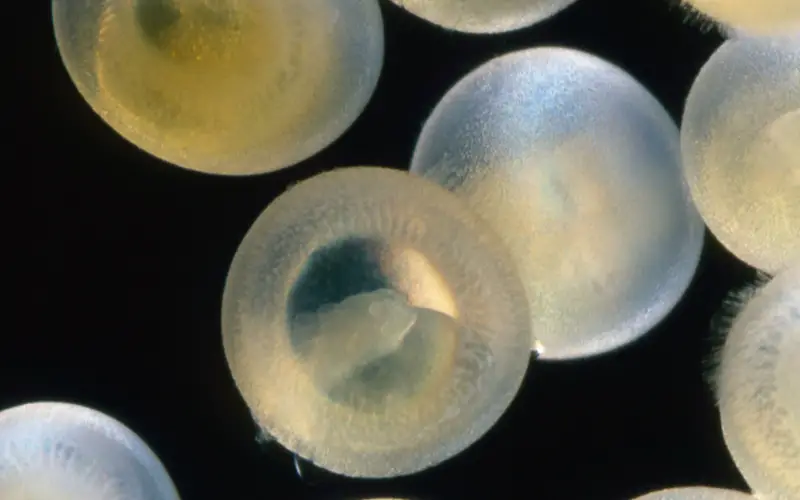How often do Cory catfish lay eggs? If you’re a hobbyist aquarium enthusiast, the Cory Catfish is likely one of your favorite catfish species.
These peaceful bottom dwellers come in many color varieties, are pretty hardy and do not require intense care – all excellent qualities for those looking to start their first aquarium.
But did you know that they lay eggs? If you don’t know this or want to learn more about Cory Catfish breeding habits, continue reading!

We’ll provide an overview of how often do corydoras lay eggs and what conditions need to be present to promote egg production, and some tips on how to distinguish between male and female Cories.
Table of Contents
ToggleHow Often Do Cory Catfish Lay Eggs?
How often do catfish lay eggs? Typically, Cory Catfish will lay eggs every 1-4 weeks; however, occasional variations can occur.
To breed successfully and produce eggs, the male catfish must court the female by chasing her and tapping her abdomen with his snout. The female then deposits her eggs on plants or other objects within the aquarium before she scoops them up in her mouth.

The male then follows and fertilizes the eggs with his sperm. Once this is complete, the female will take the eggs into her mouth for incubation. The egg-laying process takes about 16-18 hours, after which she will release the fry (baby Catfish).
What Conditions Should You Create for Maximum Egg Production?
To maximize egg production, a few conditions need to be met. First and foremost, the tank should be well-maintained with suitable water parameters (pH, temperature, etc.).
A perfect breeding setup would include plenty of vegetation, such as Java Moss or Hornwort, for the parents to deposit their eggs. A peaceful tank environment with ample hiding places is essential so the fish do not become stressed out and cease breeding.
Finally, it would help to feed your Cories smaller meals more often, ensuring they have enough breeding energy.
How to Adjust the Tank for Cory Catfish Eggs?
The cory catfish egg will not survive in a water tank unless you change its water level. List some basic factors that should be adjusted in your breeding tank:
- The water temperature should be at least 73°F (23°C) and no more than 82°F (28°C).
- Keep the pH level between 6-7.
- Regularly clean the tank to remove any debris or buildup that may inhibit egg production.
- Make sure to provide plenty of hiding spots for the fish.
- Provide vegetation such as Java Moss or Hornwort for them to lay their eggs on.
- Feed your Cories smaller meals more often to ensure they have enough breeding energy.
- Finally, maintain a peaceful tank environment with minimal disturbances so the fish are not stressed.
Following these basic steps, you can create the perfect tank conditions for Cory Catfish to lay eggs! Additionally, if you can distinguish between male and female Cories, it may help promote successful egg production.
How Can You Tell Male from Female?
What Is the Difference between Male and Female Cory Catfish? The difference is typically difficult to tell when Corydora’s gender is young. You’ll need to wait for your fish to grow to a minimum two-inch depth to differentiate.
Once the fish is mature, its size will determine its gender. The Male Corydora is the larger animal in the aquarium. Besides the smaller belly, these girls also possess broader colors and larger dorsal fins and pointed anal fins than their female counterparts.
The best way to detect whether catfish are male is to see if they’re hunting in breeding seasons. The male Corydora will court the female with chasing, bumps, and other displays.
How Long Do Corydoras Take to Lay Eggs?
How long are cory catfish pregnant? Corydoras generally lay their first batch of eggs somewhere between 6-9 months old. After the female lays her eggs, the male fertilizes them. The catfish fry (baby fish) will hatch about 5 days after Corydoras laying eggs.
During this time, it’s essential to watch the parents as they may try to eat or remove the eggs from where they were laid. Separating them from the community tank is best if you notice this behavior.
Do Cory Catfish Breed Easily?
Yes, Cory Catfish are known to be relatively easy to breed in the home aquarium. Catfish spawn during the rainy season when food is abundant in their environment.
Raising cory catfish begins with spawning, where a female and male pair up and deposit eggs onto a flat rock or other surfaces. Following fertilization, the eggs will hatch within three days and should reach adulthood within about three months.
To encourage successful breeding, it is essential to keep water quality high and maintain clean conditions for them to thrive. Additionally, providing plenty of hiding places, such as dense piles of plants, can give them the security they need for successful breeding.
How Many Eggs Do Cory Catfish Lay?
On average, a female Cory Catfish will lay between 10 and 50 eggs per spawning. However, some species can produce up to 200 eggs at once. Depending on the species, these eggs are laid in batches and hatch within 4-5 days.
Providing plenty of vegetation for the female corydoras is essential so she can lay her eggs in there safely. Java moss and Hornwort are two great options for corydoras.

Additionally, providing the tank with plenty of hiding spots can help create a stress-free environment for the fish to breed in.
By following these steps and maintaining clean conditions, you should be able to encourage successful egg production from your Cory Catfish.
Do Cory Catfish Lay Unfertilized Eggs?
Yes, Corydoras catfish can lay Infertilised Eggs; the Unfertilized cory catfish eggs are generally white or clear in color and will not hatch. They are most commonly found when the catfish is not in breeding fish season and has no intention of reproducing.
It’s worth noting that Cory Catfish eggs should never be eaten as they can carry harmful bacteria and pose a risk to your fish’s health.
Will All Corydoras Eggs Be Fertilized and Hatch?
Corydoras eggs don’t need to all be born. There’s merely no female able to produce all the eggs. During breeding corydoras, check eggs to ensure you don’t have unfertile eggs and avoid contaminating the fertilized eggs.
There are generally more fertilized eggs than underutilized eggs but no guarantee of how much. Unfertilized eggs won’t hatch, while fertilized eggs should hatch until problems occur. When breeding Cory catfish successfully, you must have a good action plan for eggs.
What Do Fertilized Cory Catfish Eggs Look Like?
How to tell if Cory eggs are fertile? Look for a few telltale signs when checking if Corydoras Eggs are fertile. Eggs will start to turn orange as they near fertility and may even have small black spots.
Fertile eggs can often be seen wobbling, resulting from the embryo moving. If the egg does not move when lightly prodded with a finger, it is likely infertile.
The best way to verify that your cory fish eggs are fertile is by using an aquarium magnifying glass, which allows you to check inside the egg and see if an embryo is present.
Fertilized vs. Infertilised Cory Catfish Eggs
Maybe you looked into eggs thinking of whether or not you should be expecting a child Corydor. Thankfully, fertilized eggs are easy to identify. In 2-4 weeks, fertilization can produce darker eggs. Dark brown spots indicate embryonic development.
Infertile eggs do not change color, causing moldy structures. When an unfertilized egg turns yellow or becomes ill, fungi usually grow in them. Typically the bacteria eat the dead material. These bacteria create an egg-white fungus structure.
Do Corydoras eat their eggs?
Yes, Corydoras eat their eggs if not cared for properly in an aquarium. If the water quality is not maintained and there is no adequate food supply, the fish may turn to eating their eggs as a source of protein.
To prevent this, any tank with Corydoras must have proper filtration, lighting, and food sources. Additionally, providing plenty of hiding spots for the fish can help reduce the possibility of egg predation.
Corydoras are sensitive to sudden changes in water conditions, so it’s crucial to maintain a consistent level of water quality by performing regular water changes and monitoring parameters closely.
Cory catfish egg development can also be hindered if predatory fish are in the aquarium, as they may eat the eggs before hatching. To prevent this, provide plenty of hiding spots for your Corydoras and ensure high water quality.
How Long Do Cory Catfish Eggs Take to Hatch?
How long do Cory eggs take to hatch? Corydoras eggs take roughly seven days to hatch. The hatching process usually begins with the egg sticking to a plant leaf or other submerged object in the tank. Within 24 hours of hatching, the fry will swim freely and feed on tiny foods like infusoria.
It’s essential to provide the fry with various food sources to thrive and grow. It can take up to 15 days for fry to reach 1/4 inch in size, so monitoring their growth rate and adjusting feeding is essential.
Cory Catfish eggs Hatching time.
It takes 3-5 days to spawn eggs. In rare instances, it may take 7 days before eggs hatch sooner. This varies depending on species and water conditions, including temperatures.
As soon as the eggs hatched, the Corydora tails flit through the eggs. It is just an indication if you notice an egg with a tail. The fry may take 1-2 days to hatch fully from the egg.
After hatching, remove any unfertilized eggs from the tank to prevent contamination and promote a healthy environment for the fry.
What to Do with Cory Catfish Eggs?
You might have seen eggs in the glass or seen breeders’ activity. Ohhooooh! The exciting bit starts with the laying of the eggs. Use your fingers to remove eggs from the glass.
Place eggs inside a container that contains adequate ventilation for antibiotics. Change the water once a day, and within three days, the Corydora eggs begin hatching.
Here are some tips on what to do with Corydoras eggs:
4 Tips for Caring for Corydoras Eggs
1. Remove Unfertilized Eggs
Unfertile eggs can contain bacteria, so take out those. Those bacteria will spread throughout fertilized eggs, destroying the cache if left alone. Occasionally, the fertilized egg changes color in about a day and turns brownish. Those eggs that have no fertilization will remain black. Whether or not one egg is turning, it is good to begin the separation process.
2. Place the Eggs in a Separate Container
To make things easier, you should use separate containers for the eggs. The eggs can easily be put into tiny containers and slid from the tank’s bottom. It will give your egg mates an adequate refuge and protect you if a problem occurs with your tank.
These containers also help in the detection and identification of microorganisms. You can keep them in the aquarium. It will not be harmful. It’s easy to get eggs out of containers.
3. Manage the Egg Environment
When you transfer eggs to another bucket, make sure the temperature is adequate. Remember that it’s best to be between 70 and 80 degrees Fahrenheit. Warm temperatures can help eggs hatch faster. Another helpful item for environmental protection is the following.
4. Add an antibacterial agent.
Some additional materials are necessary to prevent the egg from molding or becoming ill. The aquarist can find several options to reduce carbon in filters because this will neutralize harmful bacteria.
Eggs lay on leaflets in the wild, which protect them from infections. Catappa and Indian almonds can be viewed as an alternative to chemical compounds. Almond leaves produce microorganisms and serve as food for frying.
How to Hatch Cory Catfish Eggs?
Many people are interested in hatching their fish eggs but need help figuring out where to start. It cannot be easy to hatch fish eggs successfully if you’re unsure how to do it.
This video will show you how to hatch Cory Catfish eggs successfully. You’ll learn what supplies you need, the best way to set up your hatching tank, and how to take care of the new baby fish.
How to take care of Cory catfish eggs? Once you have successfully hatched your Corydoras eggs, taking good care of them is crucial. The fry is small and delicate, being extremely sensitive to water conditions.
Water temperature should be around 78-80 degrees Fahrenheit, and the pH should remain stable between 6.5 and 7.5. It’s also essential to ensure enough oxygen levels in the water and some form of filtration to keep it clean.
Caring for Cory Catfish Babies
Once the fry has hatched and you’ve moved the parents into the main tank, it’s time for a plan. The children are small and need a minimal amount of food.
They can eat a couple of dozen fresh-hatched brine shrimps each day. It’s pretty simple for those needing a grasp of live brine shrimp. During the week, the fry may start to feed it raw flake foods and live shrimp. They may also get daphnia or microworms.
Start Adding Food
Once it hatches, the fry is fed newly hatched brine shrimp and other similar live foods. The baby will eat well within six days. The juveniles are expected to be medium-sized (1.5 – 2.5 ′′) yellowish juvenile clamfish.
You may also feed them coarsely chopped fish food and finely crushed bloodworms. Newly hatched Catfish fry eat everything that fits inside their mouths. The fry should receive a diet three to three times each day from birth.
Set up a dedicated grow-out tank.
Setting up a separate breeding tank to properly monitor cory catfish can be beneficial. It will help the fry grow faster. The best size of this grow-out tank can be 20 gallons, but 10 gallons is also available if there is not enough fish. The bare bottom tank is easy to clean.
Add a Few Hiding Places
Upon eggs hatching, it is possible to see the fry. Nevertheless, there must be sheltered habitats to protect the fry. It is also possible to use driftwood or aquatic vegetation for aquariums. They provide an ideal home for young fry. Lastly, avoid filter replacement during such periods. It would also stop babies from getting buried in filters and being killed by them.
Conclusion
So, how often do Cory catfish lay eggs? In conclusion, Cory catfish are an exciting freshwater fish species with a unique lifecycle. They typically lay eggs every three to four weeks, depending on the female’s health and the water conditions. You may need to adjust their diet or water quality if they become less active or stop laying eggs altogether. Corys should be fed a balanced diet to ensure they remain healthy, and their tank should have regular water checks, a stable pH and temperature levels. While they can require a little extra care compared to other fish, they can still provide aquarium owners with years of entertainment and companionship with proper maintenance. They will make a fantastic addition to any tank!
You might also like
- Do Cory Catfish Eat Their Eggs? (5 Essential Tips & Tricks)
- Cory Catfish Eggs 101: A Comprehensive Guide (for Beginners)
- Are Spotted Raphael Catfish Aggressive? (Solved & Explained)
- How Big Do Spotted Raphael Catfish Get? (You’ll Be Shocked)
- How Long Does Cory Catfish Live? – Cory Cat Lifespan (FAQ)
- Female Vs Male Cory Catfish: 99.9% Accurate Sexing Guide




